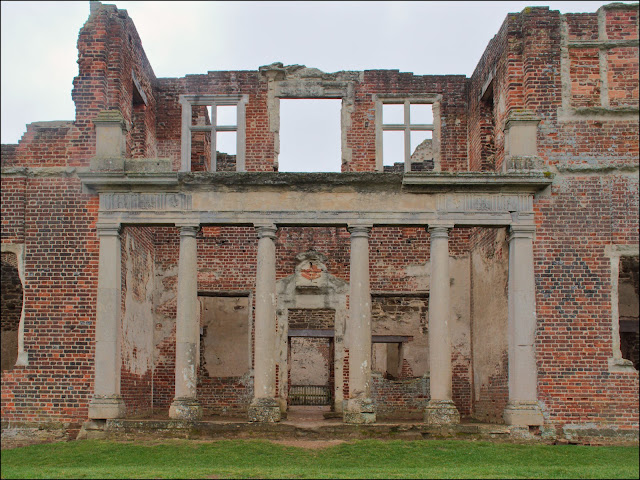...came forth more photographs. During the last excursion, in search of ruins in Bedfordshire, I took a lot more photos than I needed, some of which were not much to do with my intended aims and others that just didn't fit in. Come and have a peek inside my scatterbrained approach to gathering photographs.
A more imaginative representation of the ruined Houghton House - maybe I do believe in ghosts (just a little bit!).
Though it's not ghosts, but trolls, who inspired this post. Although all the comments I get here are polite and encouraging, I do get occasional phone calls criticising my efforts - "You didn't make much of that church, brother!" OK, Les, here's a few extra pics.
And here is what's left of a consecration mark, which indicates where a bishop has sprinkled holy water in order to consecrate the building. There should be twelve of these crosses, inside or outside the church. Three remain at Clophill.
And in the churchyard there's a little path made with stone slabs and inscribed with what I imagine are the words of members of the community. There's a long-distance footpath that follows the Greensand Ridge, we really must explore some of it in the summer.
A quiet corner of the churchyard, with views to the farmland beyond. We also wandered down to see the "new" church, built to replace this one.
At some stage during the day my eye alighted on this budding twig, silhouetted against the grey sky.
And this is the grand avenue of trees as you approach the House. It must look very pretty in autumn.... or spring.... or summer.
Houghton House is unusual in that every side of it was designed to impress. This is also thought to be the work of Inigo Jones, the first person to take classical designs from ancient times and incorporate them into his buildings.
....the house was illuminated by a stray shaft of sunlight breaking through the clouds. It didn't last long, though the cloud layer did begin to lighten a little.
At Ampthill (it's Ampt-hill, by the way, not Amp-thill) a Robin was there to greet us with a burst of song. To be truthful, these little birds are fiercely territorial and their song is one way of defending their territory against others of their ilk, and they sing all year round.
Besides the Catherine Cross, which I showed you last time, there's also the Ampthill Camp Memorial Cross. In 1914, Lord Kitchener, speaking in the House of Lords, appealed for any former officers who were qualified to train men for the army to come forward. The Duke of Bedford, who was a former Colonel, applied and within a few weeks huts were erected and a training camp established on his park. After the war the Duke went to great lengths to discover how many men who had passed through the camp had died in battle and paid for this memorial to the 707 men lost.
The sombre skies seemed entirely appropriate for such a sad period in world history, though I wouldn't have minded a few more drifting sunbeams to light up the landscape on our walk.


























































